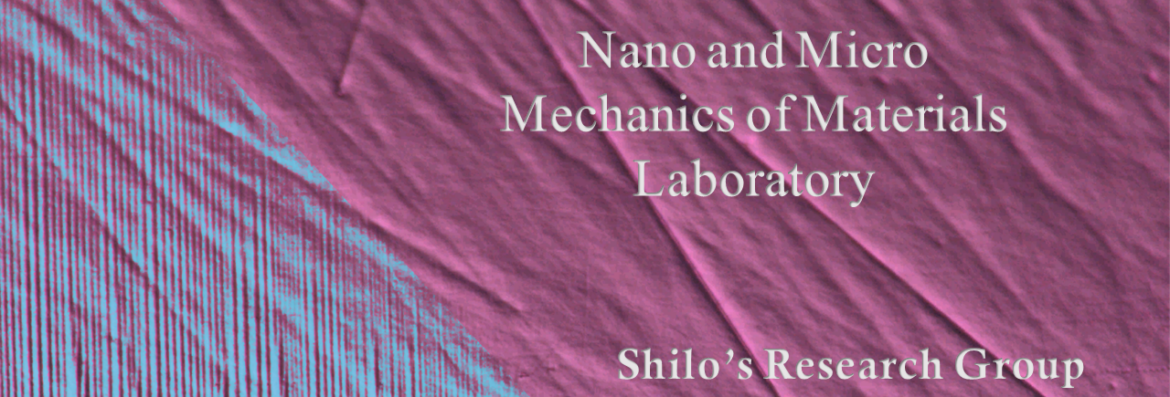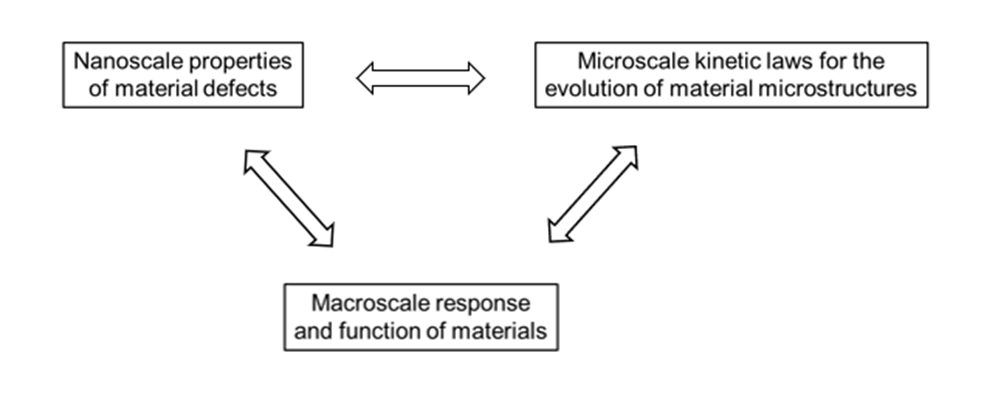Our mission
We seek to obtain knowledge on the relations between:
Experimental tools
most of the experiments performed in our lab are based on unique experimental setups that we develop to dedicatedly address the studied problem. Further, we developed several novel experimental systems for electro/magneto/thermo-mechanical testing of small samples at high rates:
- Under-microscope mechanical pulse system
- Tensile testing of thin free-standing films at high strain rates
- Micro-second electric, magnetic, and heating pulsers.[SD1]
Theoretical tools
most of our studies involve models that connect the macroscopic material response to the thermodynamics and kinetics of basic physical processes occurring at the nano and micro scales. Few recent examples are:
- A model for stress sensing using magnetostrictive composites
- Discrete twin boundary dynamic simulations
- Simulations of high rate SMA actuators[SD2]
Current projects
Novel methods for measuring and analyzing avalanche events
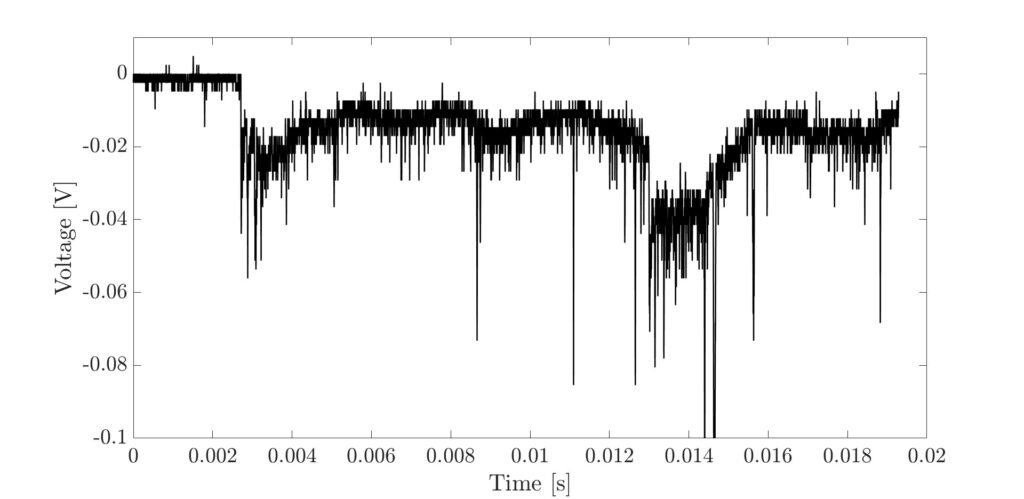 Avalanches are discrete and impulsive events that occur in many materials during various phenomena, from plasticity to magnetization switching. Avalanches also take place at larger levels of machine parts, mechanical structures, and motion of tectonic plates. In our research, we study avalanches using experimental tools that are highly sensitive to small and rapid events and are capable of detecting avalanches at the nanometer and microsecond scales.
Avalanches are discrete and impulsive events that occur in many materials during various phenomena, from plasticity to magnetization switching. Avalanches also take place at larger levels of machine parts, mechanical structures, and motion of tectonic plates. In our research, we study avalanches using experimental tools that are highly sensitive to small and rapid events and are capable of detecting avalanches at the nanometer and microsecond scales.
Specifically, we investigate twin boundary motion in SMA during slow mechanical compression via measurements of the material’s acoustic and magnetic emission. Through the experiments, we obtain new quantitative physical knowledge about fine-scale physical processes that take place during twin boundary motion. As part of this research, we collaborate with Prof. Ronen Talmon to develop novel data-driven tools for analyzing the measured signals.
Selected publications:
- “Coexistence of a well-determined kinetic law and a scale-invariant power law during the same physical process”, Phys. Rev. B. 2018.
- “Relations between stress drops and acoustic emission measured during mechanical loading”, Phys. Rev. Mater. 2019.
- “Tracking twin boundary jerky motion at nanometer and microsecond scales”, Adv. Funct. Mater. 2021.
Thermodynamics and evolution of austenite-martensite microstructures during phase transformations in SMA
 The forward and reverse martensitic phase transformations in shape memory alloys (SMA) occurs through the propagation of phase boundaries that separate the austenite and martensite phases, and can be described by stress-temperature phase diagrams. The martensitic transformations, which serve as the underlying deformation mechanisms in SMA, give rise to the shape memory and pseudoelasticity effects. In our research, we develop new experimental methods for direct measurements of stress-temperature phase diagrams of SMA.
The forward and reverse martensitic phase transformations in shape memory alloys (SMA) occurs through the propagation of phase boundaries that separate the austenite and martensite phases, and can be described by stress-temperature phase diagrams. The martensitic transformations, which serve as the underlying deformation mechanisms in SMA, give rise to the shape memory and pseudoelasticity effects. In our research, we develop new experimental methods for direct measurements of stress-temperature phase diagrams of SMA.
The experimental setups are typically mounted to an optical microscope, such that the microstructure evolution during the phase transformation is visualized and captured. Based on the captured images, we propose a model that accounts for the energies associated with the microstructure; particularly, the contribution of twinning disconnections to the total energy, which was overlooked in previous models. Fittings of model predictions with measurements based on microscopy images, together with minimization of the overall microstructural energy, provide quantitative evaluations of the twin boundary and twinning disconnection energies. The obtained values represent atomistic-scale material properties that cannot be measured directly.
Selected publications:
“A new experimental method for measuring stress-temperature phase diagram in shape memory alloys”, Scripta Materialia, 2017.
“Analysis of austenite-martensite phase boundary and twinned microstructure in shape memory alloys: The role of twinning disconnections”, Acta Materialia, 2018.
High-rate martensitic transformation in SMA: Mechanisms of motion, the evolution of microstructure, and kinetic relations
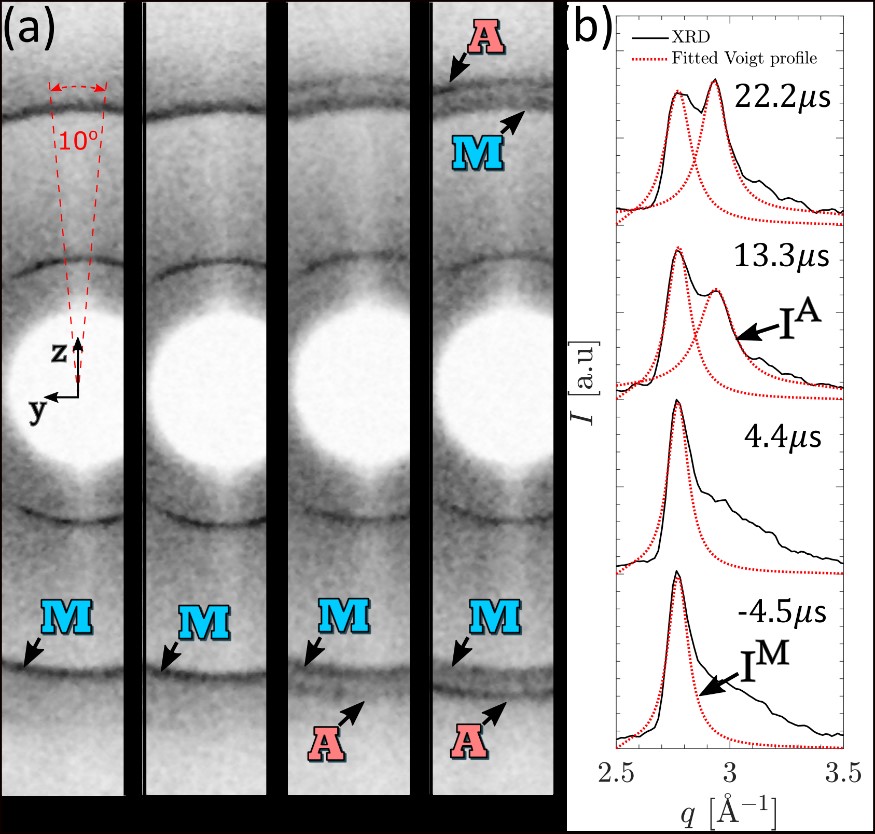 The martensitic transformation is a rapid phase transformation between two solid atomic arrangements. This process occurs in many natural and engineering crystalline materials and serves as the underlying deformation mechanism in shape memory alloys (SMA).
The martensitic transformation is a rapid phase transformation between two solid atomic arrangements. This process occurs in many natural and engineering crystalline materials and serves as the underlying deformation mechanism in shape memory alloys (SMA).
The question “how fast is the martensitic transformation?” appears in any textbook on introduction to materials science, but its answers are either qualitative or unsupported by experimental results. We develop thermo-mechanical setups that provide the necessary conditions for studying the transformation kinetics at the high driving force regime. By combining several unique characterization techniques, we track the transformation evolution with high spatial and temporal resolutions.
These include microsecond-scale time-resolved optical microscopy and x-ray diffraction along with high-bandwidth force measurements. The obtained knowledge is valuable for the development of novel modeling approaches, novel materials, and powerful high-rate shape memory alloy actuators.
Selected publications:
- “Dynamics of Phase Fronts During High-Driving-Force Transformation of Shape Memory Alloy Wires“, Shape Memory and Superelasticity, 2021.
- “The evolution of the martensitic transformation at the high-driving-force regime“, Journal of alloys and compounds, 2021.
- “Kinetics of the reverse martensitic transformation in shape memory alloys under an abrupt heating pulse“, Scripa Materialia, 2017.
High-rate actuation of SMA
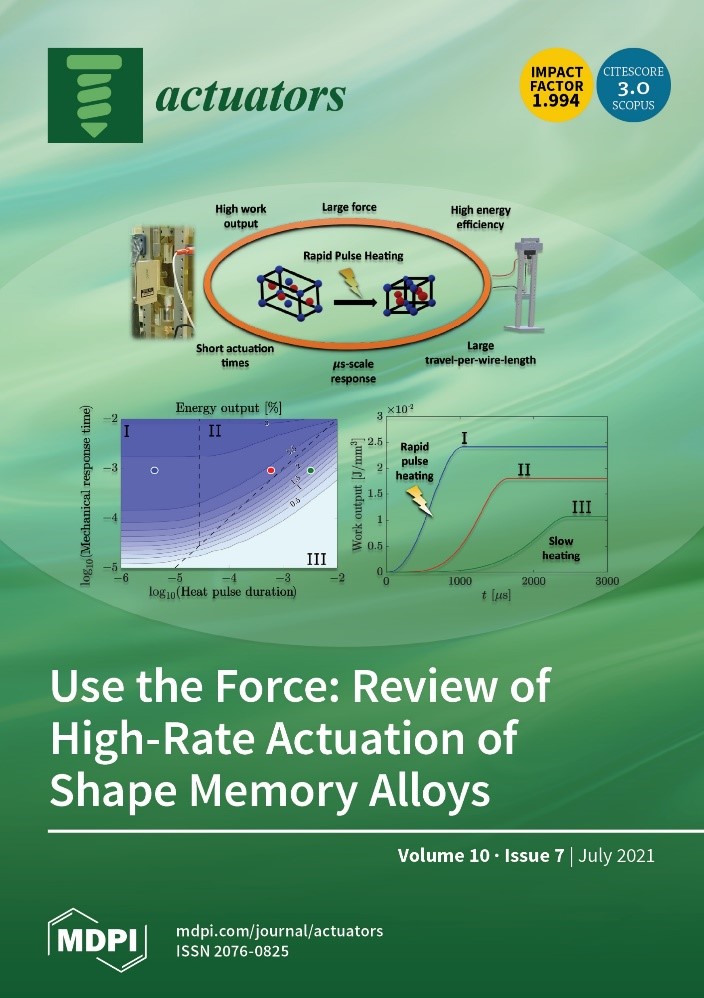 Shape memory alloy (SMA) actuators are prime candidates for use in powerful high-rate applications, such as safety systems in vehicles, due to their unique high work-per-volume yield. High-rate actuation of SMA can provide improved energy efficiency and total actuator performance with respect to slow-rate applications.
Shape memory alloy (SMA) actuators are prime candidates for use in powerful high-rate applications, such as safety systems in vehicles, due to their unique high work-per-volume yield. High-rate actuation of SMA can provide improved energy efficiency and total actuator performance with respect to slow-rate applications.
We develop novel actuation methods based on the micro-scale mechanics of such functional materials. These can provide large force, high work output, extremely short response and actuation times, along with large displacements.
Selected publications:
- “Review of High-Rate Actuation of Shape Memory Alloys“, Actuators, 2021.
- “A fast and powerful release mechanism based on pulse heating of shape memory wires“, Smart Materials and Structures, 2017.
- “Mechanical Response of Shape Memory Alloys Under a Rapid Heating Pulse“, Experimental Mechanics, 2016.
- “Self-propagating miniature device based on shape memory alloy“, Journal of Physics Communications, 2018.
Twinning dynamics
Twinning is a special case of interface-driven plasticity, that dominates the overall mechanical response in many structural and smart materials. Our group performs a comprehensive theoretical and experimental study that examines relationships between atomistic structures of twin boundaries, barriers and mechanisms of motion, and kinetic relations for twin boundary motion. This leads to the formulation of structural and kinematic models that enhance the understanding of twin boundary mobility and pave the way for controlling twinning and producing materials with improved performance.
Selected publications
- “Twin motion faster then the speed of sound”, PRL, 2009
- “The kinetic relation for twin wall motion in Ni-Mn-Ga”, JMPS. 2011.
- “The kinetic relation for twin wall motion in Ni-Mn-Ga – Part 2”, JMPS. 2013.
- “Inertia controlled twinning in Ni-Mn-Ga actuators: a discrete twin boundary dynamics study”, Shape Memory and Superelasticity, 2017.
- “Variability of twin boundary velocities in 10M Ni-Mn-Ga measured under μs-scale force pulses”, Shape Memory and Superelasticity, 2020.
- “Twin boundary structure and mobility”, Acta. Mater., 2021.
Additive Manufacturing of Shape Memory Alloys
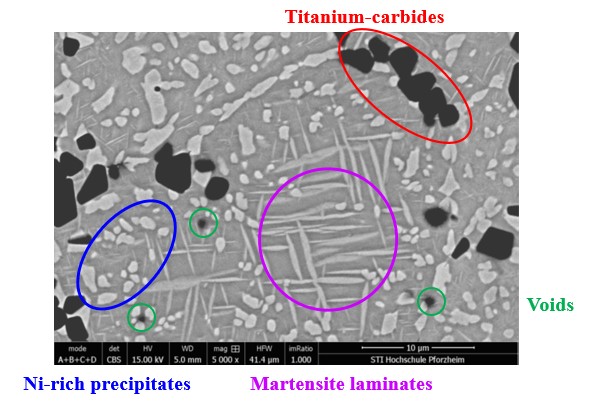 Existing technologies for manufacturing Shape Memory Alloys (SMA) are limited to simple structural shapes, which hinder the progress of many applications.
Existing technologies for manufacturing Shape Memory Alloys (SMA) are limited to simple structural shapes, which hinder the progress of many applications.
A technology for additive manufacturing (AM) can overcome this limitation and open the route for manufacturing complex structures.
Our group develops a novel method for AM of SMA, based on digital light processing and subsequent de-binding and sintering, which enables better control over the microstructure compared to conventional melting-based AM methods.
Biomechanical and biomolecular processes in stretched fetal membranes
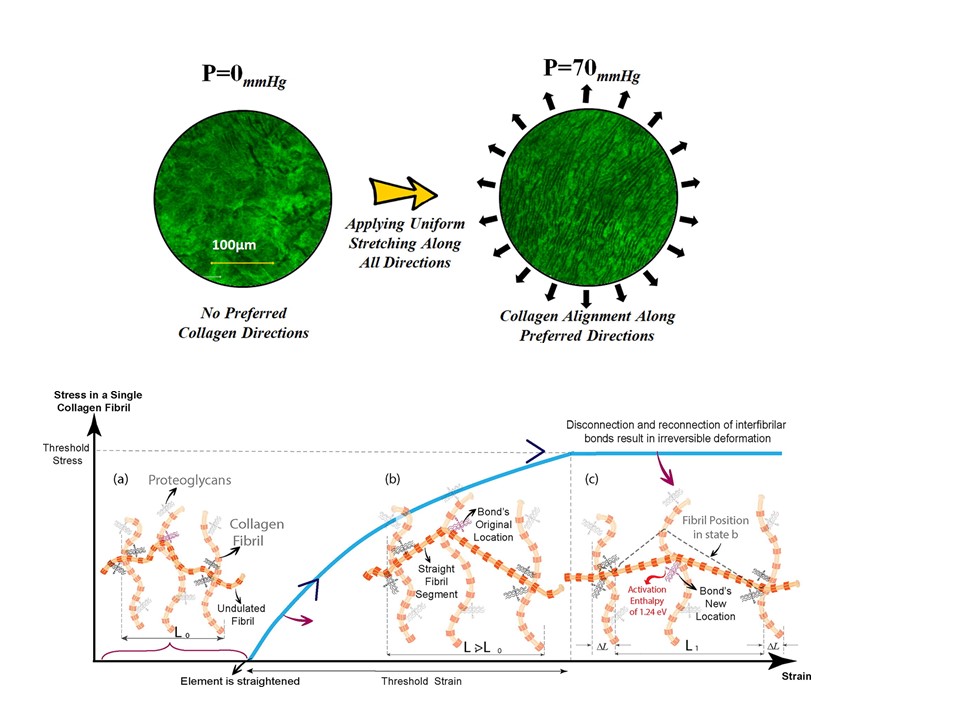 Many medical studies indicate on the possible relation between preterm labor and mechanical stresses that are applied on the fetal membrane (FM).
Many medical studies indicate on the possible relation between preterm labor and mechanical stresses that are applied on the fetal membrane (FM).
In a collaboration with Prof. Eliezer Shalev from the Technion’s Faculty of Medicine, we study live FM tissues under mechanical conditions similar to those prior to contractions.
Our results revealed an irreversible mechanical behavior that results in a residual strain that does not recover upon unloading. We introduce a new model for the mechanical response of collagen tissues, which accounts for the irreversible deformation and provides predictions in agreement with experimental results.
Further, we revealed an unexpected collagen rearrangement in the FM that indicate a deviation from the expected equibiaxial stress state. We also measured the activation enthalpy of interfibrillar bonds in live human FM and found that it is mainly associated with ionic bonds. This result implies that manipulations of the concentration of ions, such as calcium and magnesium, may allow regulation of the strength and structural integrity of the FM. Nowadays, we explore whether the stress-induced biomolecular changes eventually lead to contractions and labor initiation.
Selected publications:
- Characterization of irreversible physio-mechanical processes in stretched fetal membranes, Acta Biomater. 2016.
- Collagen bundling and alignment in equibiaxially stretched human amnion, J. Biomechanics, 2020.
- Enthalpy of Collagen Interfibrillar Bonds in Fetal Membranes, J. Biomechanics, 2021.

